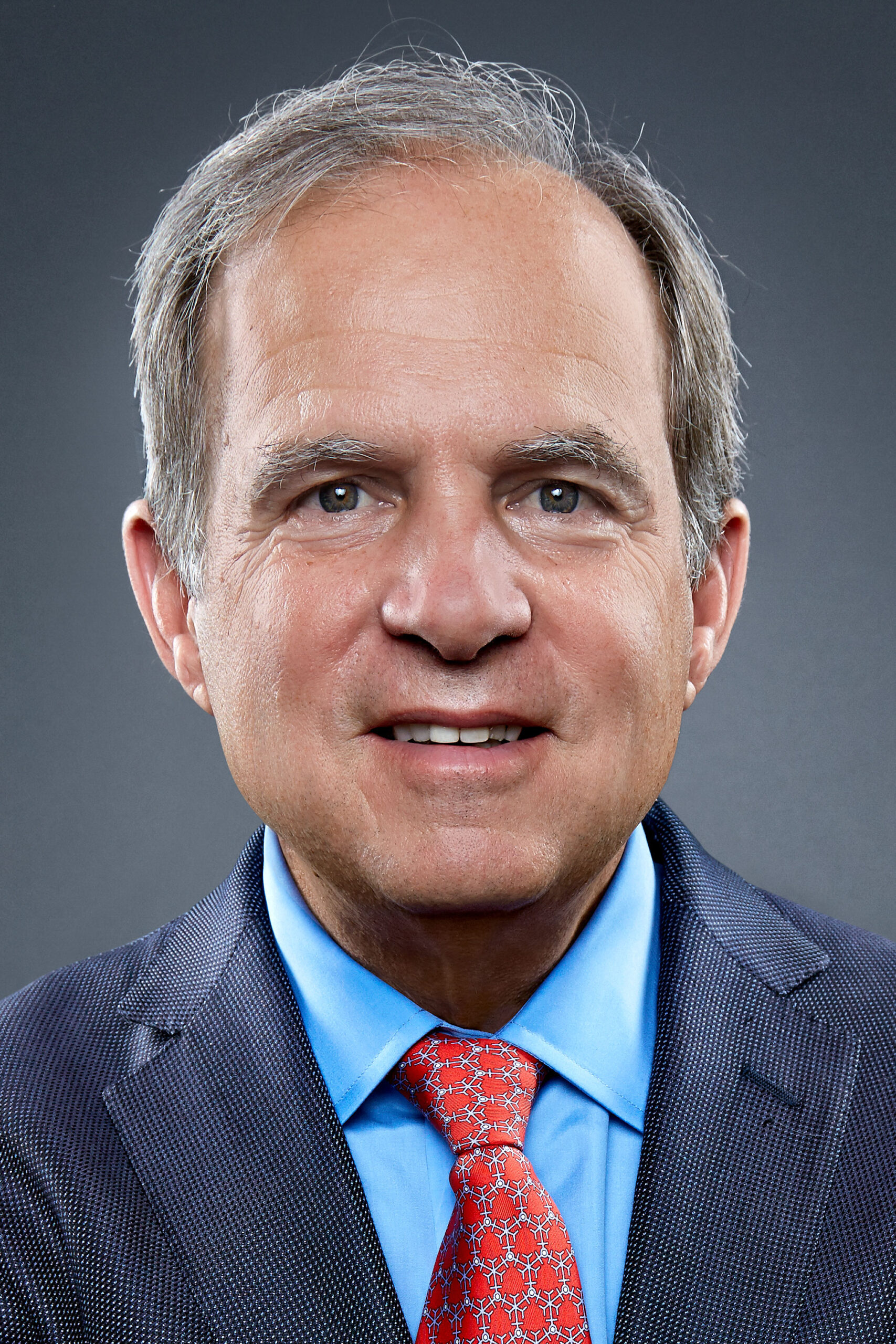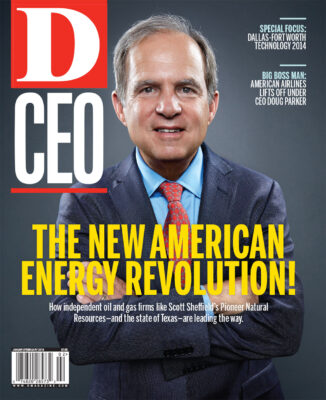PIONEER RESTRUCTURES
Sheffield has led Pioneer from its earliest days as a firm called Parker & Parsley Petroleum Co., based in Midland, through its merger with the T. Boone Pickens-founded Mesa Inc. in 1997, and its subsequent rebranding as Pioneer Natural Resources Co. According to 2012 figures from the Texas Railroad Commission, Pioneer is now the third-largest oil producer in Texas, behind Occidental Permian and EOG Resources. Pioneer began its renewed domestic focus in 2006-’07, just before the Great Recession hit. World oil prices then plunged from a high of around $140 in the summer of 2008 to $35 by year’s-end.
To keep Pioneer’s workplace intact, Sheffield had to make some tough decisions, defying the likes of Wall Street. When the financial crisis dug in, for example, Pioneer had 44 operating rigs drilling new wells in the Permian Basin. “When commodity prices fell, oilfield service costs don’t go down [with them], because of long-term contracts,” Cheatwood recalls. “As a group, with Scott leading, we decided to shut down every rig. It made no sense to pay high prices for services based on $100 oil prices when [the actual price] was around $35.”
One reason Pioneer has thrived is because Sheffield has been able to identify risks to the company, and to the industry generally, early on.
Pioneer’s big onshore “liquids” push, focusing on the more lucrative natural gas liquids and oil, came in late ‘09-‘10. Sheffield raised $8 billion of capital to accelerate development in these positions. Some three years earlier, he had already reorganized Pioneer’s structure from mostly “functional” to a “team” concept, with different functions such as land, geosciences, and engineering working together to develop common goals and strategies.
Sheffield also began pursuing vertical integration in earnest in 2009. For example, Pioneer acquired an oilfield services pumping division in Colorado to assist with fracking jobs. This services division was built up in West Texas and expanded to the Eagle Ford and the so-called Barnett Combo Play, an area of the Barnett known for yielding rich liquids. “It’s 300,000 horsepower—the 13th-largest service companies in terms of horsepower,” Sheffield says, referring to the power of Pioneer’s fracking equipment. “Then we realized, if you are in the pumping services business, you [also] need to be in the sand business.” Because sand is required to stimulate fractures in horizontal wells, Pioneer purchased one of the largest industrial sand mines in the U.S. last year, in Brady, Texas, for a reported $297 million. “We are now the largest employer in Brady,” Sheffield says.
Along the way, observers say, the company has maintained a sharp focus on its employees. “It’s so important to treat everybody equally, and with respect, throughout the organization,” Sheffield says. For example, Pioneer doesn’t have an “executive floor” at its headquarters on Irving’s O’Connor Boulevard. Instead, top executives there are scattered throughout Pioneer’s 20 or so floors (up from three in 1997). Sheffield maintains an open-door policy, and the company stresses culture so successfully, it’s been ranked among the Top 100 Places to Work by The Dallas Morning News for the last five years—and among the top three in the large-company category for the last four.
UNDERSTANDING RISK
One reason Pioneer and its employees have thrived is because Sheffield has been able to identify risks to the company, and to the industry generally, early on, as though he had a sixth sense. Indeed, understanding the shift from geologic risk from conventional exploration to the economic risk inherent in unconventional exploration has underpinned Pioneer’s successful approach.
For example, Pioneer uses traditional 3-D seismic, geo-steering software that streams real-time geology data, plus micro-seismic technology, using sound to understand the dynamics underground. “Using geo-steering, we have geologists working 24 hours a day, monitoring where that drill bit is on every place we drill horizontally to perform the best fracking jobs,” Sheffield says.
Adds Cheatwood: “In the past, when pursuing conventional exploration projects, say in deep water in the Gulf of Mexico, we mainly quantified geologic risk, and drilled vertically to test. Now we concentrate on the source and the reservoir, because they are one and the same. It comes down to where the most oil-in-place is located.” Unconventional reservoirs like the Bakken, Eagle Ford, and especially the Permian, with its so-called stacked zones, have the right recipe, Cheatwood says.
As a result, geologic risk has shifted to economic risk. Well costs need to align with commodity prices. Experience in the Eagle Ford led Pioneer to realize that extra money had to be spent on science. “We will spend an extra $2 million per well now in the northern Spraberry/Wolfcamp,” Sheffield says. “Our gross spending with Sinochem will be $2.2 billion to $2.3 billion for the whole Spraberry field … When you tell people that you have 100 to 150 years of inventory, which we do, how are you going to accelerate that? Sinochem will be our partner for the next 20 to 25 years. Production will be rising significantly.”
•••
WORKING THE MEGA-BASIN
The Permian Basin, located in parts of West Texas and an adjoining area of southeastern New Mexico, covers an expanse 250 miles wide and 300 miles long. Passing through Midland-Odessa on Interstate 20, the Basin’s commercial hub, you see an energy Mecca, bustling for miles on either side of the highway with oil and gas-related businesses. Four of the Permian’s 38 counties are Pioneer’s main drilling targets—Midland, Martin, Upton, and Andrews.
From the 1950s through the 1990s, firms began drilling deeper and deeper into the Wolfcamp Shale, which sits atop the Spraberry Shale, to a depth of nearly 8,000 feet. From 2000 to 2010, firms including Pioneer were drilling to the lower realms of the Wolfcamp Shale, beyond 11,000 feet. “We began drilling deeper vertically and opening up many more zones to make producing more economical,” Sheffield says. Pioneer, the largest producer in the Spraberry/Wolfcamp, currently is operating 27 rigs—12 of which are horizontal—with 7,000 producing wells. Sheffield says there are 18,000 vertical wells in all in the Spraberry/Wolfcamp, and another 70,000 vertical wells in the Permian’s Midland Basin.
“The Spraberry/Wolfcamp shales are multiple stacked plays, with each zone being about 300-400 feet thick, like the single zone of the Eagle Ford,” Cheatwood says. “… This is a new concept.”
Cheatwood explains how these unique stacked zones were made possible—how the “recipe” was perfected over time: “We are sitting right in the middle of the [Midland] Basin, a stinking nasty place to be. There were no critters to eat the organic matter. The air is stagnant with low circulation. We have a high kerogen [a mixture of organic chemical compounds] content, which is desirable, and enough brittle minerals in there so we could frack in this simple geologic position.” Pioneer’s Chinese partners call this area the thousand-layer cake.
The Permian Basin represents nearly 60 percent of Texas’ oil production, and Texas’ oil production represents about 25 percent of all U.S. oil production. More than 29 billion barrels of oil, and 75 trillion cubic feet of gas, have been produced in the Permian so far. The ratings agency Moody’s suggests that “redevelopment” of the Spraberry/Wolfcamp Shale could push production there above 2 million barrels per day. Saudi Arabia, by contrast, produces about 10 million barrels a day.
Additions to the U.S. oil supply by the Bakken, Eagle Ford, and Permian plays currently stand at about “2.5 million barrels of oil equivalent per day,” Sheffield says. “Were it not for shale oil today, crude prices would be much higher.” Just now, he says, the Spraberry/Wolfcamp is producing nearly 500,000 barrels per day, a figure that will grow to 2.5 million per day in 20 years. Sheffield says 200 independent firms currently are gearing up for a major production run in the Permian Basin.
Even so, some worry about the long-term supply of oil and gas, given the shale plays’ faster depletion rates, and the fact that oil prices have stayed in a range that’s made production profitable for a while now. When firms of any size experience a drop in commodity prices, production inevitably declines. “What causes the price drop—whether a financial crisis or from oversupply—determines how long it will last,” Sheffield says. Energy expert Dr. James Smith, of SMU’s Cox School of Business, expects oil prices to remain near the $100 per barrel level, “with, however, the added volatility that comes from supply disruptions or demand shocks. New U.S. oil supply has taken pressure and tightness off the market.”
Few firms have contributed to this new supply like Pioneer Resources. And thankfully, in the view of CEO Sheffield, there are enough hydrocarbons around to keep companies such as Pioneer operating—and operating successfully—for a long, long time to come.






